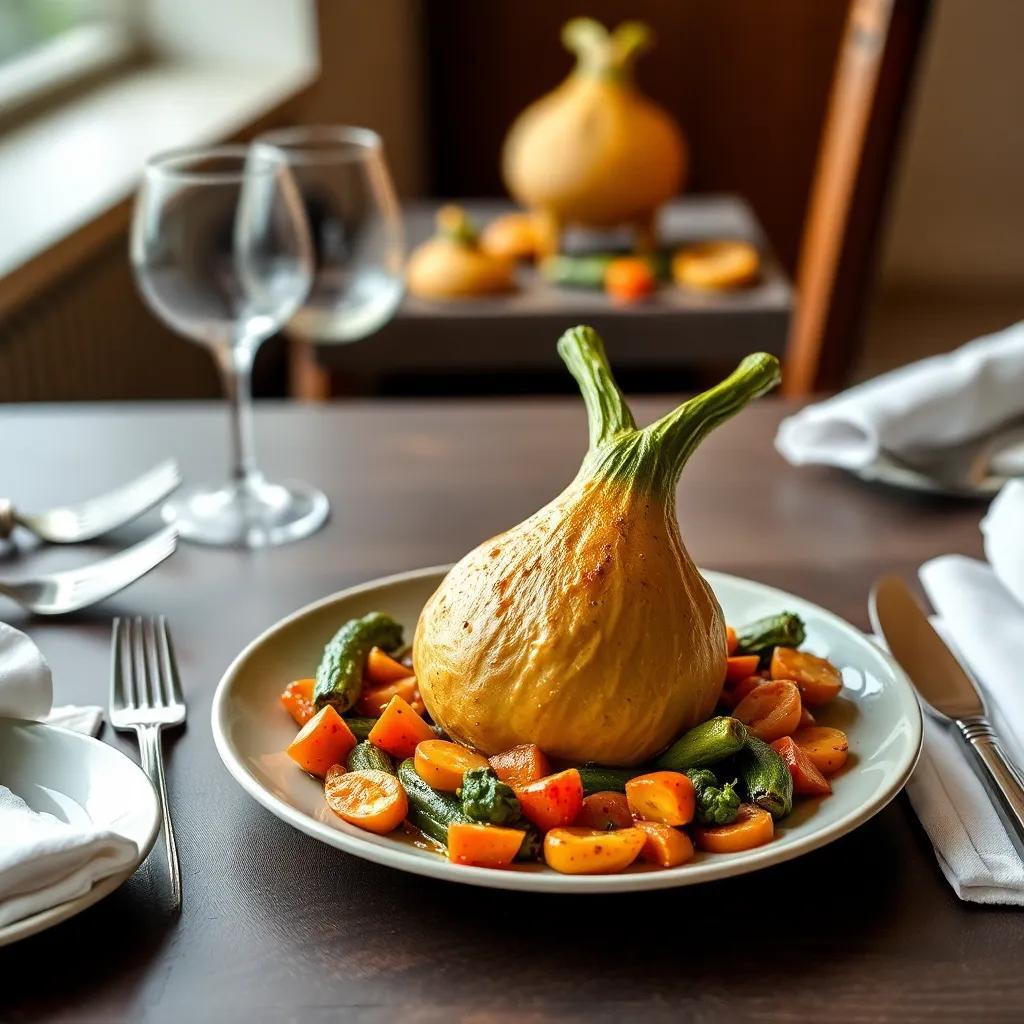Mastering Classic French Onion Soup: Easy, Rich & Comforting Recipe
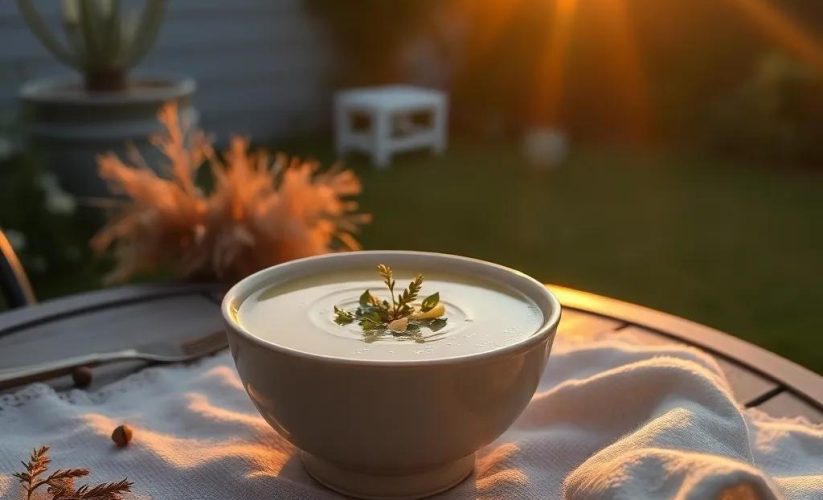
Mastering Classic French Onion Soup: Easy, Rich & Comforting Recipe
🌍 Cuisine: French
⚙️ Difficulty: Medium
Ingredients
Nutrition Facts
350 kcal
Instructions
- In a large heavy-bottom pot or Dutch oven, melt the butter with olive oil over medium heat.
- Add the thinly sliced onions, stir to coat, and cook for about 10 minutes, stirring occasionally, until they just begin to soften.
- Sprinkle the sugar and salt over the onions. Continue to cook, stirring often, for 40–50 minutes until the onions are deeply caramelized and golden brown. Be careful not to burn.
- Add the minced garlic and cook for an additional minute until fragrant.
- Pour in the white wine (if using) and deglaze the pot by scraping up any browned bits from the bottom. Let it simmer until almost evaporated, about 3 minutes.
- Add the beef broth, chicken broth, bay leaf, and thyme. Stir to combine and bring to a simmer.
- Reduce the heat to low and let the soup simmer gently uncovered for 20–30 minutes. Taste and adjust seasoning with salt and pepper.
- While soup simmers, preheat your oven broiler. Arrange baguette slices on a baking sheet and toast until golden, about 1–2 minutes per side.
- Ladle the hot soup into oven-safe bowls or crocks, place toasted baguette slices on top, and generously sprinkle with grated Gruyère cheese.
- Place the bowls on a baking sheet and broil until the cheese is melted, bubbly, and golden brown, about 3-5 minutes. Watch carefully to avoid burning.
- Carefully remove from oven and cool slightly before serving. Enjoy your rich, comforting French onion soup!
Serving Suggestions
- Serve with a simple green salad dressed with vinaigrette to balance the richness.
- Pair with a dry white wine such as Sauvignon Blanc or a light red like Pinot Noir.
- Offer crusty French bread alongside for extra dipping pleasure.
- Add fresh thyme or parsley garnish for an aromatic touch and freshness.
- Try using a mix of Gruyère and Emmental cheese for a nuanced cheese flavor.
- For a vegetarian version, substitute beef broth with hearty vegetable broth.
- Serve as a starter or light meal on chilly evenings to warm you up.
Table of Contents

Intro
There’s something utterly captivating about a bowl of classic French onion soup—a dish that effortlessly combines depth, warmth, and the cozy comfort of homemade cooking. This recipe takes you on a satisfying journey to master this timeless favorite without overwhelm. While it involves a bit of patience to develop those perfectly caramelized onions, the process is straightforward and deeply rewarding, allowing you to build layers of rich flavor with simple techniques.
Ideal for chilly evenings, casual dinner parties, or whenever you crave a soothing starter with character, this soup elevates humble ingredients into something truly special. The inviting aroma that fills your kitchen as the onions slowly brown is just the beginning—it’s a dish that promises both nurturing comfort and a touch of elegance. Whether you’re impressing guests or treating yourself to a soul-warming meal, this recipe strikes the perfect balance between rustic charm and classic French sophistication.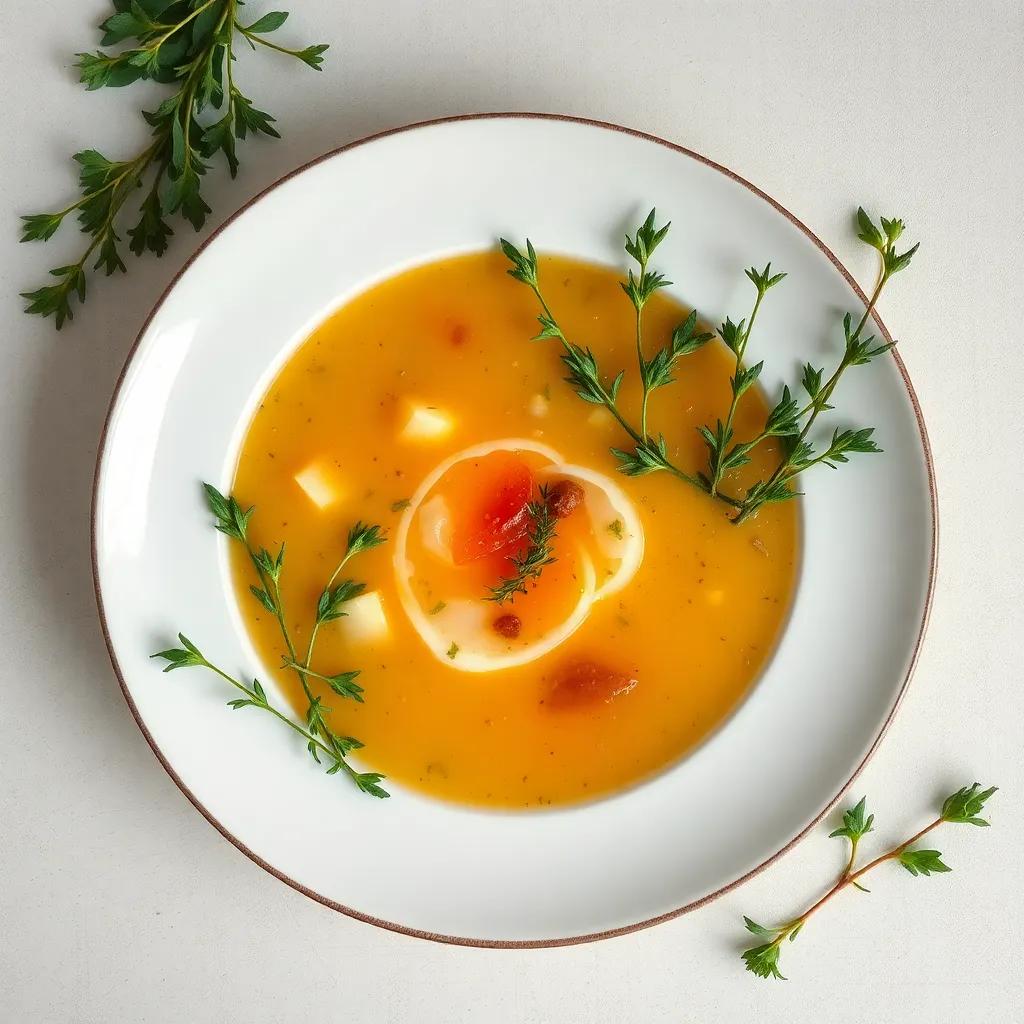
Ingredient Notes
When crafting the perfect French onion soup, a handful of key ingredients truly elevate the dish from simple to sublime. Understanding their roles and choosing them wisely can make all the difference in your finished bowl.
Yellow Onions: These are the soul of the soup. Their natural sweetness and sturdy texture hold up beautifully through the slow caramelization process, developing the deep, golden-brown color and complex flavor that define classic French onion soup. When selecting onions, look for large, firm bulbs with smooth skin and no bruises or sprouts. While sweet onions like Vidalia can work, they tend to be softer and can turn mushy faster, so yellow onions remain the preferred choice. If yellow onions aren’t available, a mix of yellow and shallots can add a subtle nuance, but avoid red onions as they impart a sharper, less traditional taste.
Gruyère Cheese: This Swiss cheese is the crowning glory atop the soup, lending a nutty, slightly salty, and creamy melt that forms the characteristic golden crust. Its excellent melting properties create that luscious, gooey layer that makes each spoonful so satisfying. When purchasing Gruyère, go for a good-quality, aged variety with a firm texture and rich aroma. If you can’t find Gruyère, Emmental or a mild Swiss cheese can serve as a suitable substitute, though the flavor profile may be a touch milder and less complex.
Beef Broth: The broth forms the flavorful base of the soup, contributing savory depth and a hearty foundation. Using homemade beef broth or a high-quality low-sodium store-bought option is essential; it offers control over salt levels and richness. A rich, clear broth results in a balanced soup where the sweetness of the onions shines without being overwhelmed. For those seeking a lighter or vegetarian adaptation, vegetable broth can be used with added umami boosters such as soy sauce, miso, or mushrooms to mimic the meaty depth.
Dry White Wine: While optional, a splash of dry white wine adds a subtle acidity and aromatic lift that brightens the soup and deglazes the pan to bring up those cherished browned-onion bits stuck to the pot. Choose an unoaked, crisp white like Sauvignon Blanc or Pinot Grigio for freshness without sweetness. If you’d rather skip alcohol, a splash of apple cider vinegar or a squeeze of lemon juice at the end can mimic that tang, though the flavor won’t be quite the same.
Taking the time to select and understand these ingredients brings authenticity and richness to your French onion soup, turning it into a truly classic experience. Each one plays a vital role—whether it’s the gradual sweetness of the onions, the melting golden cheese, or the savory broth base—working harmoniously to create a soup that comforts as much as it delights.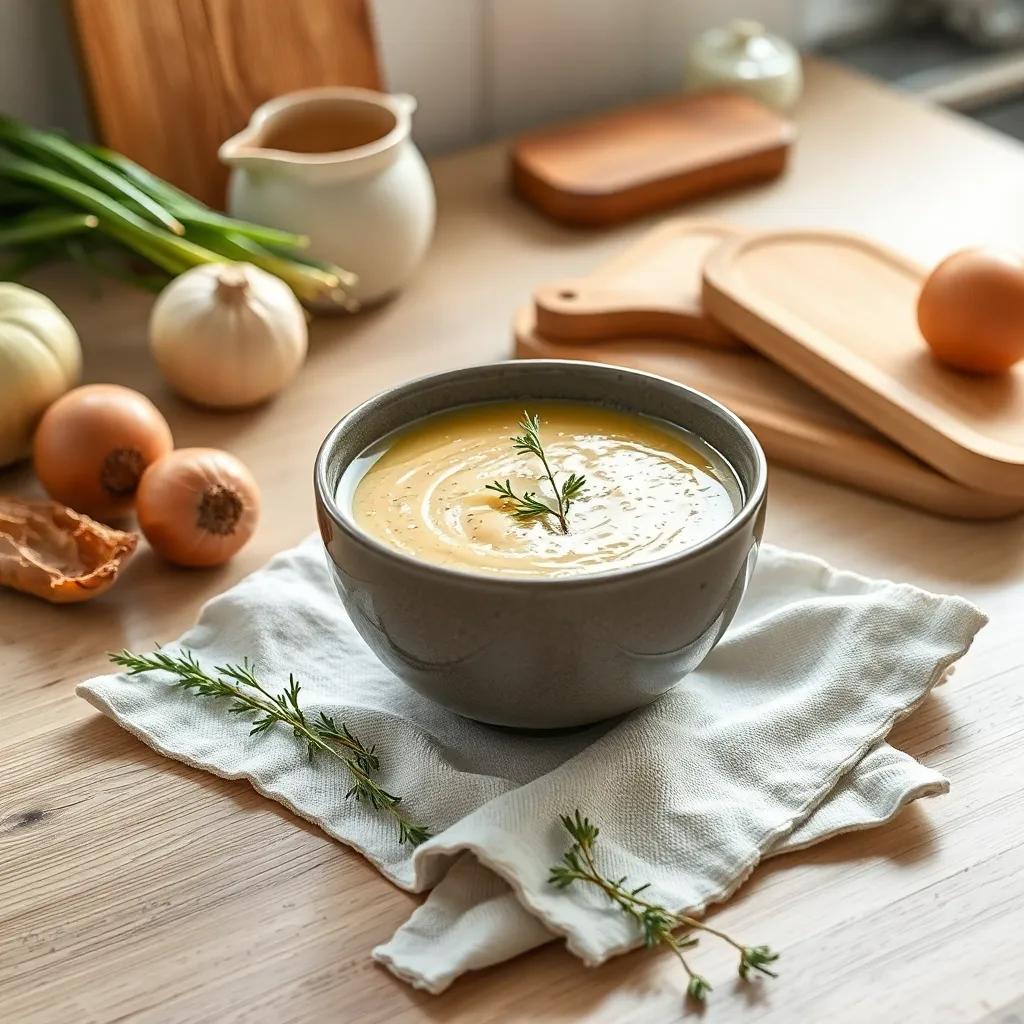
Tips & Variations
Mastering classic French onion soup means embracing patience and technique, but here are some expert tips and variations to take your soup from good to unforgettable, all while adapting it to your preferences or dietary needs.
- Perfecting Caramelization: Slow and steady wins the race. Cook your onions over medium-low heat, stirring frequently to develop that rich, deep caramel color without burning. Rushing this process with higher heat risks bitterness. If your onions start sticking, add a small splash of water or broth—this helps loosen the fond and keeps things moist.
- Balancing Sweetness and Savory: The addition of sugar is subtle but important—it jumpstarts caramelization and enhances natural onion sweetness. Feel free to experiment with alternatives like a drizzle of honey or maple syrup if you prefer a more nuanced sweetness. Remember, seasoning with salt early helps draw moisture and intensify flavor, but always taste toward the end to adjust for balance.
- Broth Blends and Boosts: The classic mix of beef and chicken broth creates rich complexity, but feel free to customize. For deeper umami, add a splash of soy sauce, a few dried mushrooms, or a bit of tomato paste during simmering. Vegetarians can use a robust vegetable broth enriched with miso or dried porcini mushrooms for that meaty depth without animal products.
- Gluten-Free and Bread Variations: Traditional baguette slices provide the perfect base for the melted cheese, but if you’re gluten-free, opt for gluten-free bread or toasted polenta rounds. For an extra special twist, try rye or sourdough for slightly tangier notes that complement the soup’s richness.
- Cheese Twists: Gruyère is classic, but mixing cheeses adds layers of flavor. Combining Gruyère with Emmental or a mild Comté can introduce nuttier or earthier tones. For a lighter version, consider melting fontina or mozzarella, though the cheese crust may be less complex. Vegan eaters can melt plant-based cheeses labeled for high-heat use or skip the cheese topping altogether and garnish with fresh herbs.
- Wine Alternatives and Enhancements: If you skip wine, don’t lose the deglazing step—it’s key for flavor. Try white grape juice with a teaspoon of lemon juice or a splash of white balsamic vinegar. For another dimension, add a teaspoon of sherry or brandy if you prefer a fortified wine flavor.
- Serving Style: To avoid soggy bread, toast your baguette slices well and place them carefully on the soup just before broiling. Some cooks like to toast baguette and cheese separately, then layer after ladling soup to maintain extra crunch. Alternatively, turn the soup into an elegant entrée by serving it in smaller, individual crocks topped with cheese and grilled.
- Make It Ahead: This soup actually mellows and deepens in flavor if made a day ahead. Prepare the caramelized onion base and broth overnight, then reheat gently, toast the bread, and broil the cheese right before serving. This is great for entertaining or busy weeknights.
These tips and variations allow you to personalize your French onion soup while maintaining its soul-warming essence. Whether you’re crafting a traditional bowl or adapting it to special diets, the heart of this classic dish lies in those golden caramelized onions and a bubbling crown of cheese.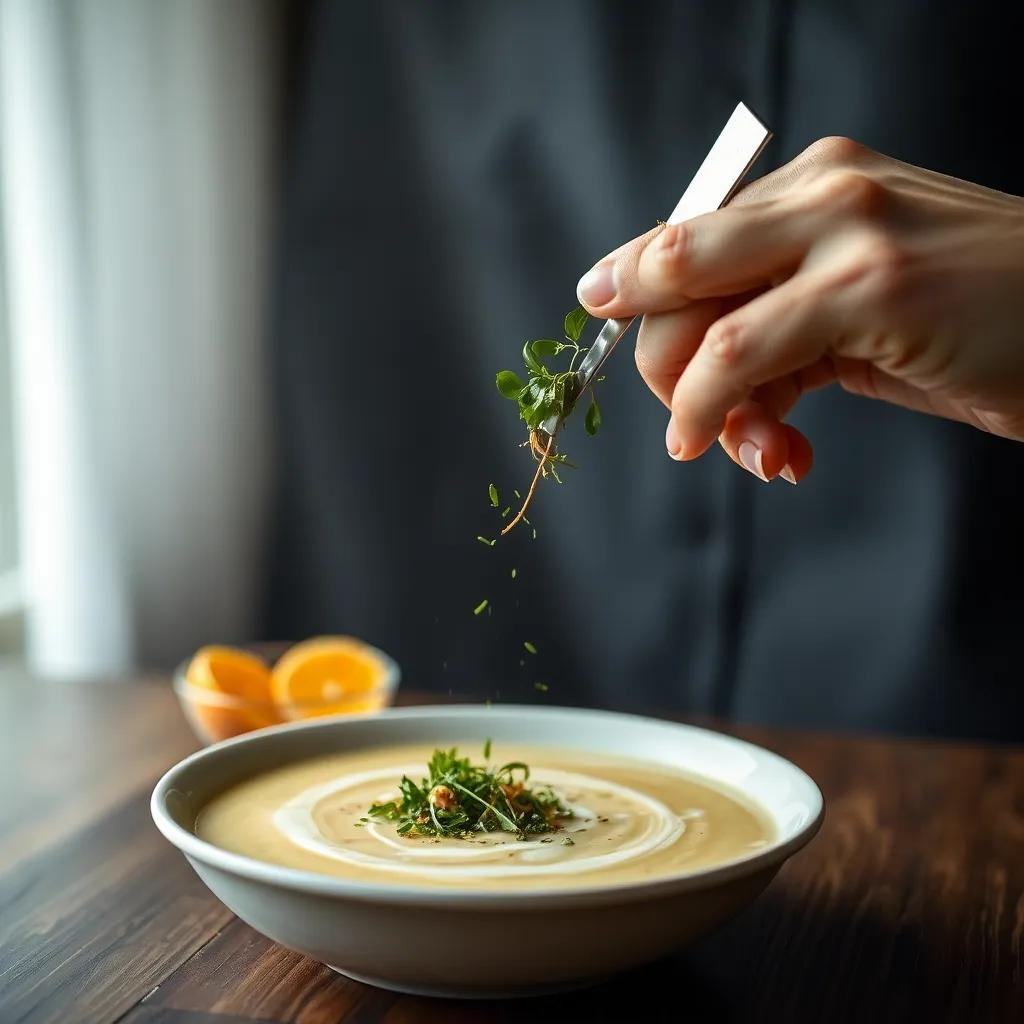
Leftovers & Storage
After savoring a bowl of this rich, comforting French onion soup, you might find yourself with leftovers worth preserving carefully to enjoy another day. Proper storage ensures the soup maintains its deep flavors and satisfying texture, so you can relish the next serving just as much as the first.
When it comes to saving your soup, remove the toasted baguette slices and cheesy topping before storing—these components are best enjoyed fresh and separately because bread tends to soften and cheese can become rubbery or oily over time. Store the pure soup base itself in an airtight container to lock in freshness and prevent it from absorbing other fridge odors.
In the refrigerator, French onion soup will keep well for up to 3 to 4 days. For storing, opt for glass or BPA-free plastic containers with tight-fitting lids; these help maintain the soup’s flavor and aroma while making reheating safe and convenient. Avoid filling containers all the way to the top to allow slight expansion if you plan to freeze.
If freezing, portion the soup into individual servings for easy grab-and-go meals later on. Frozen French onion soup will stay at its best quality for about 2 to 3 months. Use freezer-safe containers or heavy-duty resealable bags (removing as much air as possible). When you’re ready to enjoy it, thaw overnight in the fridge and gently reheat over low heat on the stove to preserve the nuances of the broth and caramelized onions.
When reheating leftover soup, be mindful to stir occasionally and add a splash of broth or water if it has thickened slightly in the fridge or freezer. To bring back that iconic finishing touch, lightly toast fresh baguette slices and grate fresh Gruyère (or your preferred cheese) before broiling again, so you can recreate the classic bubbling, golden cheese topping without the sogginess that happens from storing assembled soup.
If you want to pack French onion soup for lunch or a picnic, store the soup separately in a leak-proof thermos or container. Pack toasted bread and cheese in a separate container or bag, assembling them right before eating to keep textures intact.
By planning ahead with smart storage practices, you transform your French onion soup into a flexible, make-ahead favorite that delights the palate long after the first pot is finished. This makes it not only a soul-warming dinner but also a versatile recipe to simplify busy days without sacrificing any of that old-world French charm.
Behind the Recipe
French onion soup carries with it a rich heritage steeped in both simplicity and sophistication—a humble dish born from frugality yet elevated to iconic status across the globe. Its roots trace back to ancient times when onions, an accessible and inexpensive vegetable, were transformed by French cooks into a deeply flavorful soup that could warm hearts and homes during cold months. Historically, it was often regarded as a peasant’s food, made with basic ingredients and slow-cooked to coax out the natural sweetness of onions. Yet over centuries, this humble soup has graced the tables of French bistros and royal courts alike, symbolizing how patience and technique can create culinary magic from the simplest elements.
In many ways, French onion soup exemplifies the essence of French cooking: respect for ingredients, layered flavors, and a devotion to craft. The slow caramelization of onions is not just a cooking step but a ritual that unlocks richness and complexity, rewarding those who take the time. The addition of toasted bread and bubbling Gruyère cheese atop completes this comforting dish, offering a satisfying contrast of textures and a golden, gratinéed finish that captivates the senses.
For many home cooks and chefs, French onion soup also holds personal significance as a nostalgic comfort food, reminiscent of cozy family dinners or leisurely meals shared among friends. This particular recipe honors those traditions while making the process approachable—inviting you to experience firsthand the transformation from simple onions and broth into a soul-soothing bowl of warmth and elegance.
By mastering this classic, you connect not only with a dish but with a culinary story that celebrates ingenuity, patience, and the timeless joy of savoring something both rustic and refined. It’s a reminder that great food doesn’t always need to be complicated, but it does require love and respect for each step along the way.
FAQ
Can I make French onion soup ahead of time and reheat it later?
What’s the best type of onion to use for a deep, rich flavor?
Can I make this recipe vegetarian or vegan-friendly?
Is it okay to freeze French onion soup?
What’s a good substitute if I don’t have dry white wine for deglazing?
How do I prevent my bread from getting soggy under the cheese?
Can I use different types of cheese instead of Gruyère?
Try It Yourself
There’s something truly comforting about a bowl of classic French onion soup—the rich, caramelized onions, the savory broth, and that golden, bubbling cheese topping come together to warm both body and soul. This easy recipe captures all those timeless flavors in a way that’s approachable for any home cook, making it the perfect dish to master and enjoy whenever you crave a little taste of France.
If you give this recipe a try, I’d love to hear how it turns out! Feel free to leave a comment, share your own special twists, or rate the recipe to help others discover this cozy favorite. Happy cooking, and bon appétit!










